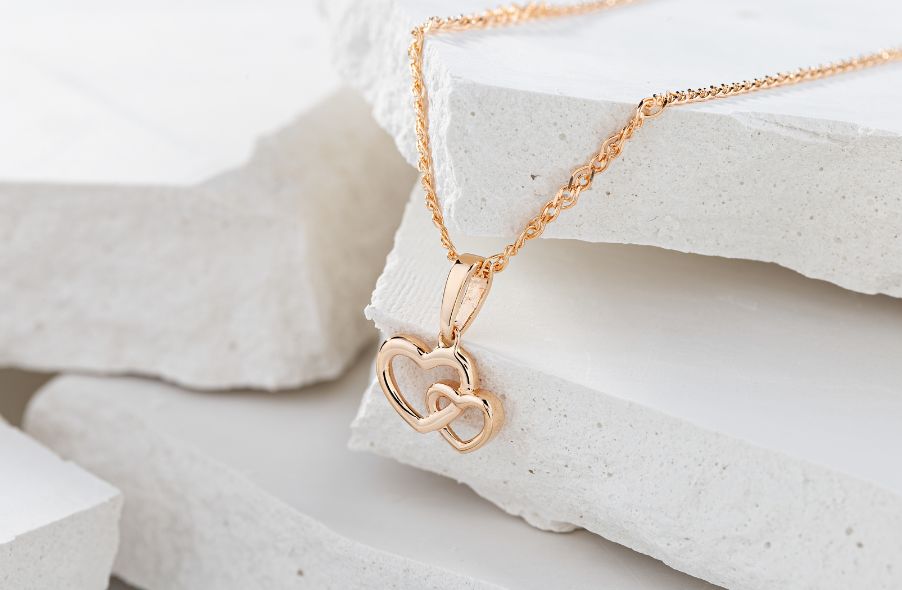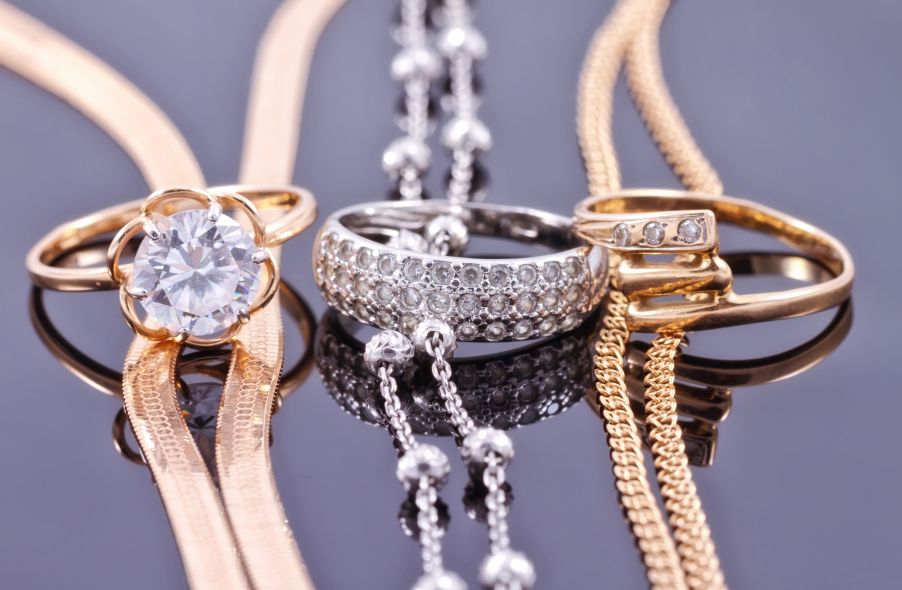
When you think of "gold," what comes to mind? For many people, it may be gold bullion or rare gold coins. However, gold jewelry is another popular association with the precious metal.
If you're interested in learning more about gold jewelry, this guide is for you. Did you know that jewelers use different types of gold in their designs? Below, we'll explore the basics of each option so that you can make an informed decision when gifting or investing in gold jewelry.
Understanding Gold
Gold is a highly valuable natural material found on Earth. It has a long history dating back to ancient times and is known for its malleability and resistance to tarnish. Gold is viewed as a symbol of luxury in many societies, making it an ideal choice for creating high-end jewelry.
Gold comes in various forms, including coins and bars for investment purposes. It is also used in everyday objects like smartphones, televisions, and dental fillings. However, its most common application is in jewelry. Let's delve deeper into how the jewelry industry utilizes gold to create stunning pieces for both commercial purposes and collectors.
Gold's Different Colors and Alloys
The world of gold jewelry extends beyond simple necklaces, rings, and bracelets. Skilled jewelers use a wide variety of colors in their modern designs to create accessories that stand out.
Gold jewelry achieves its different colors through the use of alloys. Each alloy has different characteristics and durability. When purchasing jewelry, it's important to consider not only the style but also the quality of the metal.
Yellow Gold: The Classic Choice
Yellow gold is perhaps the most well-known and classic color of gold jewelry. It is an alloy of pure gold mixed with silver, copper, and zinc. This combination creates the famous yellow shine associated with luxury and high value. Yellow gold requires the least amount of maintenance and is the purest among all available colors. It is also a safe choice for individuals with metal allergies.
White Gold: A Durable and Stylish Option
White gold is often confused with silver due to its similar appearance. However, white gold does not contain any traces of silver. It is typically a mixture of pure gold and platinum, with nickel and zinc also used in some cases. White gold has gained popularity for engagement and wedding rings due to its luxurious look and durability. It is less prone to scratching and damage, making it suitable for daily wear.

Rose Gold: A Trendy and Affordable Option
Rose gold has become increasingly popular in recent years, thanks to its unique pink hue. This alloy consists of gold, copper, and silver. The specific percentages of these metals can vary, resulting in different shades of rose gold. Higher concentrations of pure gold create a shinier appearance and a paler pink color. Jewelry made of rose gold tends to be more affordable than yellow or white gold due to the relatively low cost of copper. Additionally, the use of copper enhances the durability and resistance to tarnishing of this type of gold jewelry.
Green Gold: A Unique and Rare Choice
Compared to other gold colors, green gold is less commonly seen in jewelry. It is an alloy of pure gold, silver, and occasionally copper, resulting in a striking pale green finish. Adding cadmium to the alloy can achieve a darker green shade, but this process is rare due to the toxicity of cadmium. Finding green gold jewelry may require more effort, as it is not as popular as other colors.
Gold Karat and Purity
When discussing gold jewelry, terms like "karat" and "purity" are important to understand. Gold purity refers to the percentage of pure gold in an object. The higher the purity level, the more valuable the item. Simple tests can help determine the purity of gold, as pure gold has no magnetic properties. Jewelers also use the term "karat" to measure the purity of gold in a piece. The industry measures gold on a scale of 24 karats, with 24 karat gold being pure gold. Most jewelers create products ranging from 10 to 20 karat gold compositions for durability.
Gold Plating Options: An Affordable Choice
Gold-plated jewelry offers an affordable alternative to solid gold. Different types of gold plating include gold-filled jewelry, gold-plated or electroplated jewelry, and gold overlay jewelry. Gold-filled jewelry contains multiple layers of gold bonded to a base metal like brass or copper. Gold-plated jewelry features a thin layer of gold over a base metal, while gold overlay jewelry is a slightly more durable version of gold electroplated items. It's important to note that vermeil jewelry is a special type of gold plating that uses sterling silver as a base, making it more durable and suitable for individuals with sensitive skin.
Now that you have a better understanding of the different types of gold jewelry, you can make more informed decisions when purchasing or investing in gold. Whether you're buying a piece of jewelry for yourself or considering gold as an investment, knowing the purity level, karat measurement, and color options will help you make the right choice. If you want to explore the world of precious metals further, reach out to the experts at Learn About Gold for more information on gold investments and opening a gold IRA.
Frequently Asked Questions
Should You Invest in Gold for Retirement?
This will depend on how much money and whether you were able to invest in gold at the time that you started saving. If you are unsure which option to choose, consider investing in both options.
Not only is it a safe investment but gold can also provide potential returns. Retirement investors will find gold a worthy investment.
Gold is more volatile than most other investments. Therefore, its value is subject to change over time.
However, this does not mean that gold should be avoided. It is important to consider the fluctuations when planning your portfolio.
Another benefit of gold is that it's a tangible asset. Gold can be stored more easily than stocks and bonds. It can also be carried.
Your gold will always be accessible as long you keep it in a safe place. There are no storage charges for holding physical gold.
Investing in gold can help protect against inflation. It's a great way to hedge against rising prices, as gold prices tend to increase along with other commodities.
Additionally, it will be a benefit to have some of your savings invested into something that won't lose value. Gold tends to rise when the stock markets fall.
Another advantage to investing in gold is the ability to sell it whenever you wish. Just like stocks, you can liquidate your position whenever you need cash. You don't have to wait for retirement.
If you do decide to invest in gold, make sure to diversify your holdings. Do not put all your eggs in one basket.
Don't buy too many at once. Start small, buying only a few ounces. Add more as you're able.
It's not about getting rich fast. Rather, it's to build up enough wealth so you won't need to rely on Social Security benefits.
And while gold might not be the best investment for everyone, it could be a great supplement to any retirement plan.
How to Open a Precious Metal IRA
First, decide if an Individual Retirement Account is right for you. Open the account by filling out Form 8606. Then you must fill out Form 5204 to determine what type of IRA you are eligible for. This form should not be completed more than 60 days after the account is opened. Once you have completed this form, it is possible to begin investing. You could also opt to make a contribution directly from your paycheck by using payroll deduction.
For a Roth IRA you will need to complete Form 8903. Otherwise, the process is identical to an ordinary IRA.
To be eligible for a precious metals IRA, you will need to meet certain requirements. The IRS requires that you are at least 18 years old and have earned an income. Your earnings cannot exceed $110,000 per year ($220,000 if married and filing jointly) for any single tax year. And, you have to make contributions regularly. These rules will apply regardless of whether your contributions are made through an employer or directly out of your paychecks.
You can invest in precious metals IRAs to buy gold, palladium and platinum. You can only purchase bullion in physical form. This means you can't trade shares of stock and bonds.
Your precious metals IRA may also be used to invest in precious-metal companies. This option is available from some IRA providers.
However, investing in precious metals via an IRA has two serious drawbacks. First, they're not as liquid as stocks or bonds. This makes it harder to sell them when needed. They don't yield dividends like bonds and stocks. Therefore, you will lose more money than you gain over time.
Is buying gold a good option for retirement planning?
Although it may not look appealing at first, buying gold for investment is worth considering when you consider the global average gold consumption per year.
Physical bullion is the most popular method of investing in gold. However, there are many other ways to invest in gold. You should research all options thoroughly before making a decision on which option you prefer.
For example, purchasing shares of companies that extract gold or mining equipment might be a better option if you aren't looking for a safe place to store your wealth. Owning gold stocks should work well if you need cash flow from your investment.
You also can put your money into exchange-traded funds (ETFs), which essentially give you exposure to the price of gold by holding gold-related securities instead of actual gold. These ETFs usually include stocks of precious metals refiners or gold miners.
Can I keep physical gold in an IRA?
Gold is money, not just paper currency or coinage. It's an asset that people have used for thousands of years as a store of value, a way to keep wealth safe from inflation and economic uncertainty. Today, investors use gold as part of a diversified portfolio because gold tends to do better during financial turmoil.
Today, Americans prefer precious metals like silver and gold to stocks and bonds. Even though owning gold is not a guarantee of making money, there are many reasons why you might want to add gold to your retirement savings portfolio.
Another reason is that gold has historically outperformed other assets in financial panic periods. Between August 2011 to early 2013, gold prices rose close to 100 percent while the S&P 500 fell 21 per cent. Gold was one of the few assets that performed better than stocks during turbulent market conditions.
Gold is one of the few assets that has virtually no counterparty risks. Even if your stock portfolio is down, your shares are still yours. Gold can be worth more than its investment in a company that defaults on its obligations.
Gold provides liquidity. This means that, unlike most other investments, you can sell your gold anytime without worrying about finding another buyer. It makes sense to buy small quantities of gold, as it is more liquid than other investments. This allows you to profit from short-term fluctuations on the gold market.
Statistics
- Gold is considered a collectible, and profits from a sale are taxed at a maximum rate of 28 percent. (aarp.org)
- You can only purchase gold bars at least 99.5% purity. (forbes.com)
- The price of gold jumped 131 percent from late 2007 to September 2011, when it hit a high of $1,921 an ounce, according to the World Gold Council. (aarp.org)
- If you accidentally make an improper transaction, the IRS will disallow it and count it as a withdrawal, so you would owe income tax on the item's value and, if you are younger than 59 ½, an additional 10% early withdrawal penalty. (forbes.com)
- (Basically, if your GDP grows by 2%, you need miners to dig 2% more gold out of the ground every year to keep prices steady.) (smartasset.com)
External Links
wsj.com
- Saddam Hussein’s InvasionHelped Uncage a Bear In 1989 – WSJ
- Are you interested in keeping gold in your IRA at-home? It's not legal – WSJ
investopedia.com
bbb.org
finance.yahoo.com
How To
A growing trend: Gold IRAs
The gold IRA trend is growing as investors seek ways to diversify their portfolios while protecting against inflation and other risks.
Owners can invest in gold bars and bullion with the gold IRA. It is a tax-free investment that can be used to grow wealth and offers an alternative investment option to those who are concerned about stocks or bonds.
An investor can use a gold IRA to manage their assets and not worry about market volatility. They can also use the gold IRA as a protection against potential problems like inflation.
Investors also get the unique benefits of owning physical Gold, including its durability, portability, flexibility, and divisibility.
The gold IRA also offers many other benefits, such as the ability to quickly transfer the ownership of the gold to heirs, and the fact the IRS doesn't consider gold a currency.
Investors looking for financial security are increasingly turning to the gold IRA.
—————————————————————————————————————————————————————————————-
By: Learn About Gold
Title: A Guide to the Different Types of Gold Jewelry
Sourced From: learnaboutgold.com/blog/types-of-gold-jewelry/
Published Date: Sun, 24 Sep 2023 20:53:03 +0000
















